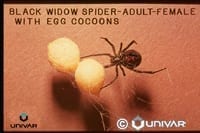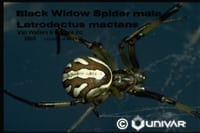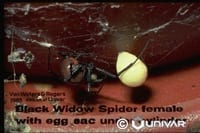Black Widows
Nearly 40,000 different species of spiders are known around the world, with around 3,000 species living in North America. With perhaps an instinctive fear of spiders in our blood, we humans tend to shy away from associating with these beasts, and given the reputations of some of them, that revulsion is understandable.
The horrors attributed to spiders are not always based on facts and accuracy however, but on misidentification, misunderstanding, and as of most recently, internet hoaxes instead.
 It is a fact that all spiders feed on other animals – mostly insects – and with this in mind we recognize that spiders deserve the right to be called “beneficial”. They also can be some of the most intelligent and fascinating bugs in nature, and if you have ever taken the time to watch an Orb Weaver making its web I hope that you too stood amazed by this ability.
It is a fact that all spiders feed on other animals – mostly insects – and with this in mind we recognize that spiders deserve the right to be called “beneficial”. They also can be some of the most intelligent and fascinating bugs in nature, and if you have ever taken the time to watch an Orb Weaver making its web I hope that you too stood amazed by this ability.
However, as much as we may appreciate the benefit spiders provide in our world, it also is important to know enough about them to learn to avoid those that may truly cause us harm, and Black Widow spiders are one of these.
In fact, they may be the only spider in North America with the potential to kill us, and over a couple of hundred years of record keeping no more than one person died each year from the venom of this spider. Now, with the availability of antivenin at most major hospitals, deaths from black widow bites are extremely rare, and in the U.S. there have been no confirmed deaths since 1983, according to one medical organization.
The effect of the bite, however, can be extremely painful, and potentially dangerous.
 The venom of most spiders acts only in the tissue in the immediate area of the bite, and with a few species, such as Violin Spiders and Hobo Spiders, that venom may be virulent enough to cause tissue to die and a small sore to appear. Black Widow venom is a bit unusual, in that it is a “neuro” toxin, and it affects the nervous system throughout the body. While the actual bite itself may feel like just a slight pin-prick, or not even be felt at all, the results of the bite can be quite intense. Within about a half hour there may be swelling and redness at the bite site itself, and within a few hours this can progress to feelings of nausea, sweating, intense spasmodic pain that travels through the limbs and body and perhaps settles in the abdomen and back. Very young children and older people are at the highest risk of serious complications from black widow venom, as their immune systems are not as effective in warding off the venom and its effects. If you suspect that you or someone else has been bitten by a black widow it is advisable to seek medical attention quickly.
The venom of most spiders acts only in the tissue in the immediate area of the bite, and with a few species, such as Violin Spiders and Hobo Spiders, that venom may be virulent enough to cause tissue to die and a small sore to appear. Black Widow venom is a bit unusual, in that it is a “neuro” toxin, and it affects the nervous system throughout the body. While the actual bite itself may feel like just a slight pin-prick, or not even be felt at all, the results of the bite can be quite intense. Within about a half hour there may be swelling and redness at the bite site itself, and within a few hours this can progress to feelings of nausea, sweating, intense spasmodic pain that travels through the limbs and body and perhaps settles in the abdomen and back. Very young children and older people are at the highest risk of serious complications from black widow venom, as their immune systems are not as effective in warding off the venom and its effects. If you suspect that you or someone else has been bitten by a black widow it is advisable to seek medical attention quickly.
The black widow is not an aggressive spider, and in fact would much prefer not to “waste” its venom on a human being. We are far too large for a spider to consider eating, and with the cost in energy needed to produce the venom a spider would certainly rather use it on the insects it captures. According to studies by universities, a black widow will not even inject venom most of the times it bites a person or some other larger animal. The bite may simply be a warning, and if a poke with the fangs is sufficient to scare away the danger then venom is not needed. It is only when the spider feels trapped and in danger that it is going to bite. This may happen if one is trapped in clothing, and cannot escape when that clothing is put on. We may reach behind some object in storage and place our hand on a black widow that is resting there, again eliciting the bite response. The female spider tends to be very protective of her egg sac, and will be more aggressive toward any perceived threat at this time, rushing over to bite whatever has touched her webbing.
 Fortunately, black widows are very distinctive spiders. Only the female is capable of biting people, and as an adult spider she is medium sized, shining black and hairless, and nearly always with a bright red spot on the bottom of her abdomen that is the shape of an hourglass. When the spiders first emerge from the egg sac they are tiny and nearly white in color. As they develop through their early stages they become darker in color, with wavy bands of tan or black on their abdomen. The male spiders eventually reach the adult stage with this final coloration – white and brown stripes and bands, but also with a white hourglass pattern on the underside of their abdomen. The females become more and more black as they grow, eventually ending up with no other colors or stripes on them. Since they are the ones that may bite us this distinctive coloration allows us to identify them quickly.
Fortunately, black widows are very distinctive spiders. Only the female is capable of biting people, and as an adult spider she is medium sized, shining black and hairless, and nearly always with a bright red spot on the bottom of her abdomen that is the shape of an hourglass. When the spiders first emerge from the egg sac they are tiny and nearly white in color. As they develop through their early stages they become darker in color, with wavy bands of tan or black on their abdomen. The male spiders eventually reach the adult stage with this final coloration – white and brown stripes and bands, but also with a white hourglass pattern on the underside of their abdomen. The females become more and more black as they grow, eventually ending up with no other colors or stripes on them. Since they are the ones that may bite us this distinctive coloration allows us to identify them quickly.
Black widows are in a family of spiders called the “comb-footed” spiders – the Theridiidae. This group includes a number of other species that are very similar in appearance, with long legs, large round abdomen, and nearly hairless bodies. However, only the black widows have the hourglass pattern, and other species also tend to be more of a dark brown than a pitch black. The other species may be able to bite people, but the effect of their venom will not have nearly the serious consequences of the black widows.
 Black widows are web spinners, using their silk to capture their food. The webs are built in a very haphazard manner, without the beautiful symmetry of the garden orb weavers. Black widow silk is some of the strongest silk in nature, and if you pass a stick through the web you will feel a distinct resistance, hear a snapping sound as the strands are broken, and see that it is a very sticky webbing. The silk is so strong that it was used to create the cross-hairs in instruments on World War 1 aircraft, allowing for the thin lines that steel wires could not provide. The black widow is comfortable only when it is in its web, and usually rests upside down to allow its heavy abdomen to hang properly. While it can move rapidly across its own webbing to capture prey, it is clumsy and out of place on the ground. Black widows simply are not designed to walk on a horizontal surface, and their awkward movements are obvious when you see one. When disturbed their first instinct likely will be to curl up in a ball, hoping to avoid whatever threat they perceived, as their defenses are not nearly as effective when they are not in their web.
Black widows are web spinners, using their silk to capture their food. The webs are built in a very haphazard manner, without the beautiful symmetry of the garden orb weavers. Black widow silk is some of the strongest silk in nature, and if you pass a stick through the web you will feel a distinct resistance, hear a snapping sound as the strands are broken, and see that it is a very sticky webbing. The silk is so strong that it was used to create the cross-hairs in instruments on World War 1 aircraft, allowing for the thin lines that steel wires could not provide. The black widow is comfortable only when it is in its web, and usually rests upside down to allow its heavy abdomen to hang properly. While it can move rapidly across its own webbing to capture prey, it is clumsy and out of place on the ground. Black widows simply are not designed to walk on a horizontal surface, and their awkward movements are obvious when you see one. When disturbed their first instinct likely will be to curl up in a ball, hoping to avoid whatever threat they perceived, as their defenses are not nearly as effective when they are not in their web.
 These are also spiders that prefer their privacy, and you are unlikely to see a black widow walking across your floor. While they need to place their webs where they will capture other bugs for food, these will most often be in out-of-the-way locations, where little human activity is occurring. Your garage can be a wonderful habitat for black widows, with its semi-darkened environment and not much traffic. Be careful when you are reaching for things that have been in storage there, such as boards against the walls, boxes or other objects piled on shelves or the floor. In the yard be cautious when picking up lumber in piles, firewood, or boards or other objects on the ground that may provide good hiding places for the spiders beneath them. When you will be doing this kind of work it is highly advisable to wear thick gloves, such as leather, to prevent spiders and other biting insects from having any opportunity to harm you.
These are also spiders that prefer their privacy, and you are unlikely to see a black widow walking across your floor. While they need to place their webs where they will capture other bugs for food, these will most often be in out-of-the-way locations, where little human activity is occurring. Your garage can be a wonderful habitat for black widows, with its semi-darkened environment and not much traffic. Be careful when you are reaching for things that have been in storage there, such as boards against the walls, boxes or other objects piled on shelves or the floor. In the yard be cautious when picking up lumber in piles, firewood, or boards or other objects on the ground that may provide good hiding places for the spiders beneath them. When you will be doing this kind of work it is highly advisable to wear thick gloves, such as leather, to prevent spiders and other biting insects from having any opportunity to harm you.
 It is also common to find children keeping black widows in jars, and having the desire to observe nature in this manner is not altogether a bad thing. It might, however, be considered a bad choice of spiders. Not knowing any better the child may poke large holes in the lid to allow air in, believing that spiders need a lot of fresh air. In one instance the black widow, in a jar in a school classroom, produced her egg capsule with several hundred eggs in it. When the eggs hatched the tiny new spiderlings easily escaped through the holes in the lid and wandered off to various places in the classroom to start their new lives. Like many other spiders the very young black widows also may partake of “ballooning”, in which they let out long strands of silk into the air, and then are carried by the wind to new locations, sometimes miles from where they began their lives. This may be one reason spiders so suddenly appear in your home…..they essentially flew in.
It is also common to find children keeping black widows in jars, and having the desire to observe nature in this manner is not altogether a bad thing. It might, however, be considered a bad choice of spiders. Not knowing any better the child may poke large holes in the lid to allow air in, believing that spiders need a lot of fresh air. In one instance the black widow, in a jar in a school classroom, produced her egg capsule with several hundred eggs in it. When the eggs hatched the tiny new spiderlings easily escaped through the holes in the lid and wandered off to various places in the classroom to start their new lives. Like many other spiders the very young black widows also may partake of “ballooning”, in which they let out long strands of silk into the air, and then are carried by the wind to new locations, sometimes miles from where they began their lives. This may be one reason spiders so suddenly appear in your home…..they essentially flew in.
All spiders have their beneficial aspects, and most kinds of spiders should be encouraged in our landscapes. Many of those found wandering inside our homes might best be placed in a jar and released outside. Black widows, unfortunately, often choose our structures for their web locations, and this brings this potentially dangerous spider into close proximity to children and pets, and given their dangerous venom this is one spider that probably is best removed when found.
For positive identification of any spider, call Chet’s Termite & Pest Management. Our number is (813) 935-7554 and we will schedule an inspection at your convenience.
